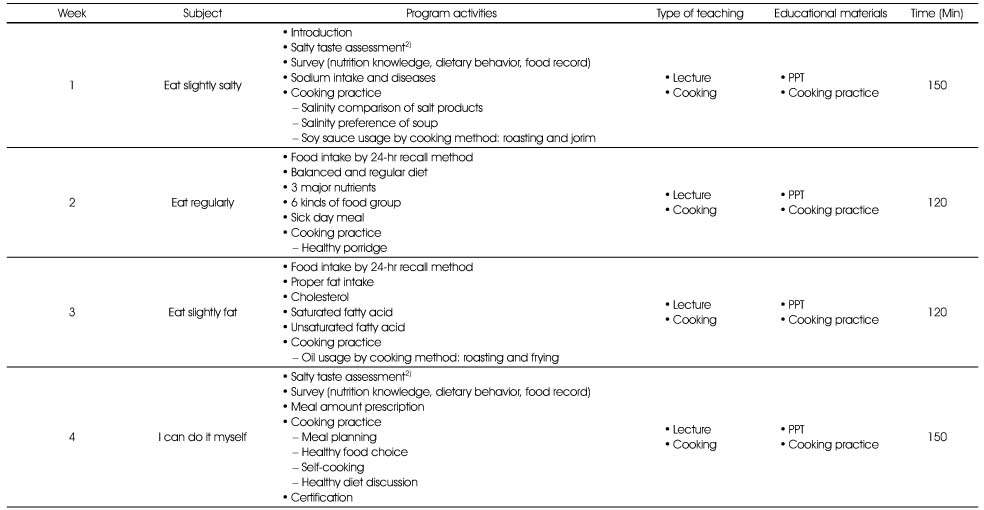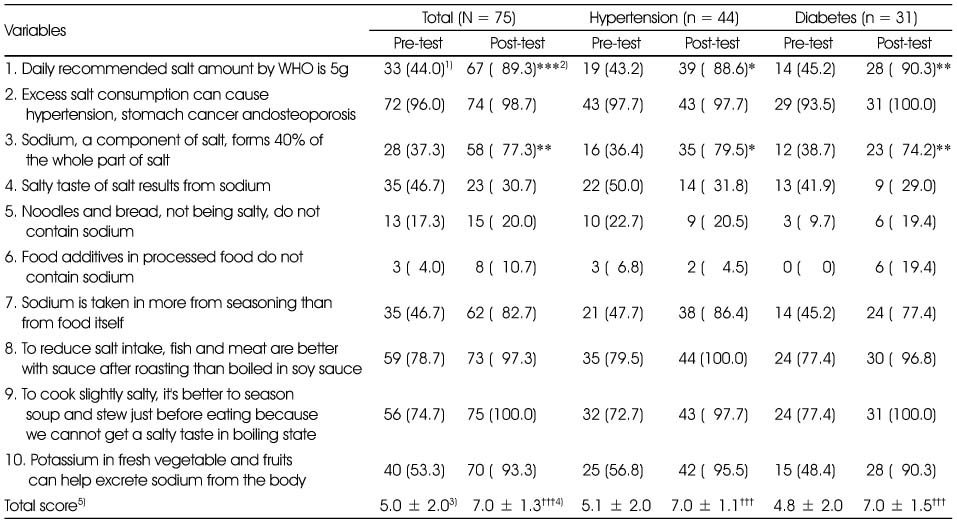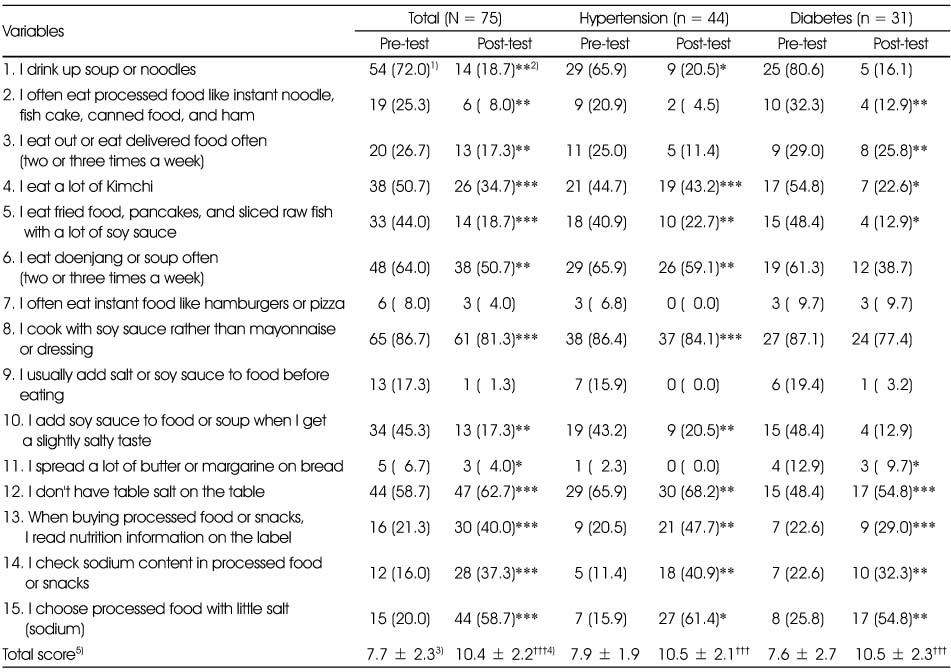Articles
- Page Path
- HOME > Korean J Community Nutr > Volume 16(5); 2011 > Article
-
Original Article
- Effects of Nutritional Education Practice Program for Cardiocerebrovascular High-risk Group at the Education Information Center
- Hang Me Nam, Seung Hee Woo, Young Ji Cho, Yun Jung Choi, Su Yeon Back, So Yeon Yoon, Jin Young Lee, Jung-Jeung Lee, Hye Jin Lee
-
Korean Journal of Community Nutrition 2011;16(5):580-591.
DOI: https://doi.org/10.5720/kjcn.2011.16.5.580
Published online: October 31, 2011
1KHyDDI (Korea Hypertension Diabetes Daegu Intiative) Project, Deagu, Korea.
2Division of Chronic Disease Control, Korea Centers for Disease Control & Prevention, Osong, Chungbuk, Korea.
3Department of Preventive Medicine & Public Health School of Medicine, Keimyung University, Daegu, Korea.
- Corresponding author: Hye Jin Lee, Korea Hypertension Diabetes Daegu Intiative Project 376-25 Samdeok-dong 3(sam)-ga, Jung-gu, Daegu 700-413, Korea. Tel: (053)428-0109, Fax: (053)422-9436, garden_1@hanmail.net
Copyright © 2011 The Korean Society of Community Nutrition
- 415 Views
- 0 Download
- 6 Crossref
Figure & Data
REFERENCES
Citations

- The impact of differential cost sharing of prescription drugs on the use of primary care clinics among patients with hypertension or diabetes
Eunja Park, Daeeun Kim, Sookja Choi
Public Health.2019; 173: 105. CrossRef - Effect of Staged Education Program for Hypertension, Diabetes Patients in a Community (Assessment of Quality of Life Using EQ-5D)
Jung Jeung Lee, Hye Jin Lee, Eun Jin Park
Journal of agricultural medicine and community health.2014; 39(1): 37. CrossRef - Comparison of the Health Behaviors according to Income and Education Level among Cardio-Cerebrovascular Patients; based on KNHANES data of 2010-2011
Ji-Yeon Choi, Seong-Woo Choi
Journal of the Korea Academia-Industrial cooperation Society.2014; 15(10): 6223. CrossRef - Effects of Nutrition Education and Personalized Lunch Service Program for Elderly at Senior Welfare Center in Jeonju
Jeong-Sook Bae, Mi-Hyun Kim, Sook-Bae Kim
Korean Journal of Community Nutrition.2013; 18(1): 65. CrossRef - Community-based Nutritional Management for Secondary Prevention of Diabetic Macrovascular Diseases
Hye Jin Lee, Jung Jeung Lee
The Journal of Korean Diabetes.2013; 14(1): 36. CrossRef - Development and Evaluation of a Community Staged Education Program for the Cardiocerebrovascular Disease High-risk Patients
Hye-Jin Lee, Jung-Jeung Lee, Tae-Yoon Hwang, Sin Kam
Journal of agricultural medicine and community health.2012; 37(3): 167. CrossRef
KHyDDI NEP Program1)
1) Korea Hypertension Diabetes Daegu Intiative Nutritional Education Practice Program
2) Salty taste material by Daegu Metropolitan City Salt Reduction Project (Patent No. 10-2007-0116957)
General characteristics of subjects
1) Values are Mean ± SD
2) N (%)
Comparison of anthropometric data and blood pressure
1) Values are Mean ± SD
2) **: p < 0.01, ***: p < 0.001 by paired t-test
3) Body Mass Index
4) Systolic blood pressure
5) Diastolic blood pressure
Comparison of salty taste assessment
1) N (%)
2) **: p < 0.01, ***: p < 0.001 by χ2-test
Comparison of nutrition knowledge
1) Correct answer's percentage
2) **: p < 0.01, ***: p < 0.001 by χ2-test
3) Values are Mean ± SD
4) †††: p < 0.001 by paired t-test
5) Higher score indicates having more nutrition knowledge, with a possible score of 0 - 10
Comparison of eating behavior
1) N (%)
2) **: p < 0.01, ***: p < 0.001 by c2-test
3) Values are Mean ± SD
4) †††: p < 0.001 by paired t-test
5) Summated score of each item. Scores on undesirable behaviors were reversed to calculate total score.
Higher score indicates more desirable eating behavior, with a possible score from 0 to 15
Comparison of nutrient intakes
1) Values are Mean ± SD
2) *:p < 0.05, **:p < 0.01, ***: p < 0.001 by paired t-test
Comparison of index of nutrition quality (INQ)
1) Values are Mean ± SD
2) *: p < 0.05, **: p < 0.01, ***:p < 0.001 by paired t-test
1) Korea Hypertension Diabetes Daegu Intiative Nutritional Education Practice Program 2) Salty taste material by Daegu Metropolitan City Salt Reduction Project (Patent No. 10-2007-0116957)
1) Values are Mean ± SD 2) N (%)
1) Values are Mean ± SD 2) **: p < 0.01, ***: p < 0.001 by paired t-test 3) Body Mass Index 4) Systolic blood pressure 5) Diastolic blood pressure
1) N (%) 2) **: p < 0.01, ***: p < 0.001 by χ2-test
1) Correct answer's percentage 2) **: p < 0.01, ***: p < 0.001 by χ2-test 3) Values are Mean ± SD 4) †††: p < 0.001 by paired t-test 5) Higher score indicates having more nutrition knowledge, with a possible score of 0 - 10
1) N (%) 2) **: p < 0.01, ***: p < 0.001 by c2-test 3) Values are Mean ± SD 4) †††: p < 0.001 by paired t-test 5) Summated score of each item. Scores on undesirable behaviors were reversed to calculate total score. Higher score indicates more desirable eating behavior, with a possible score from 0 to 15
1) Values are Mean ± SD 2) *:p < 0.05, **:p < 0.01, ***: p < 0.001 by paired t-test
1) Values are Mean ± SD 2) *: p < 0.05, **: p < 0.01, ***:p < 0.001 by paired t-test

 KSCN
KSCN








 PubReader
PubReader Cite
Cite


